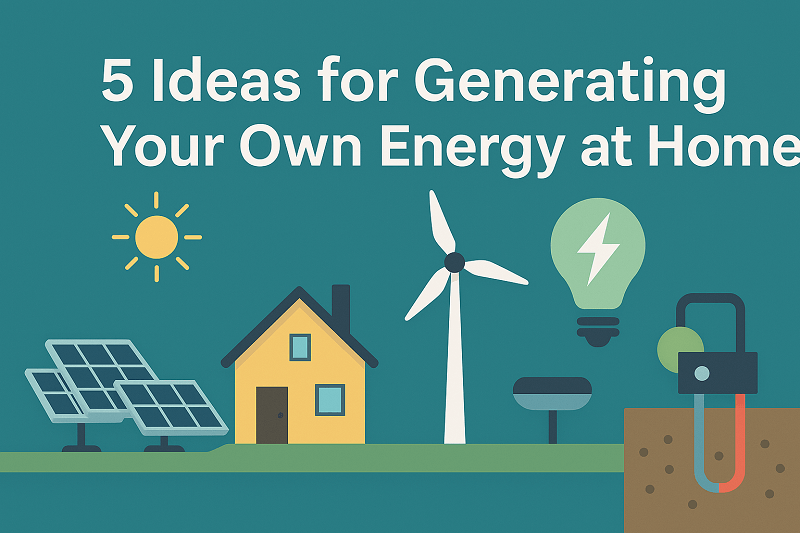
Simple, Sustainable & Smart Solutions for Every Household
With rising energy prices and growing awareness of climate change, more and more people are looking for ways to take control of their power — literally. The good news? You don’t need to live off-grid or build a wind farm in your backyard to start generating your own energy.
Today, it’s easier than ever to produce energy at home, reduce your bills, and contribute to a more sustainable future. Whether you’re ready to fully power your home or simply want to supplement your usage, here are 5 smart, practical ideas to help you take the first step toward energy independence.
1. ☀️ Install Solar Panels on Your Roof
Solar panels are the most popular and accessible form of home energy production — and for good reason.
They work by capturing sunlight and converting it into usable electricity via photovoltaic (PV) cells. Once installed, solar panels can significantly reduce your electricity bill and, in some cases, allow you to earn money by feeding excess power back into the grid.
Benefits of solar panels:
- Long lifespan (20–30 years)
- Low maintenance
- Environmentally friendly
- Can increase property value
What you’ll need:
- A south-facing roof (in the Northern Hemisphere)
- A solar installer or DIY solar kit
- An inverter and battery storage (optional but recommended)
💡 Tip: Many governments offer tax credits or subsidies for solar installations, so check what’s available in your region.
2. 🌬️ Try a Small Wind Turbine (Yes, Really!)
While wind turbines are more commonly associated with rural areas or commercial wind farms, small residential wind turbines are becoming more efficient and affordable. If you live in an open area with consistent wind speeds (minimum 5 m/s or 11 mph), this could be a great addition to your energy mix.
Why it’s worth considering:
- Generates power day and night (unlike solar)
- Works year-round
- Can complement solar panels for a hybrid system
Keep in mind:
- You’ll need space: open land or a tall tower away from buildings and trees
- May require local permits depending on size and location
🌀 Ideal for: Homes in windy regions, rural properties, or anyone looking to supplement solar energy at night.
3. 🔥 Install a Biomass Stove or Boiler
Biomass heating systems use organic materials like wood pellets, chips, or logs to produce heat. They’re an excellent way to heat your home, water, or both — while using a renewable, low-carbon fuel source.
Biomass options:
- Pellet stoves (best for single rooms)
- Log-burning stoves
- Biomass boilers (whole-home heating)
Advantages:
- Cost-effective in areas with access to cheap or free wood
- Can replace oil or gas systems
- Produces a cozy, natural warmth
Things to consider:
- Requires fuel storage space
- Needs regular cleaning and maintenance
- May need a flue or chimney
🔥 Bonus: Some countries offer incentives for switching to biomass from fossil fuels.
4. 🌊 Tap Into Geothermal Heating (Ground Source Heat Pumps)
Geothermal energy sounds futuristic, but it’s surprisingly practical — especially for heating and cooling. A ground source heat pump uses the consistent temperature below the earth’s surface to regulate your home’s indoor climate.
How it works:
- In winter, it extracts heat from the ground and brings it indoors.
- In summer, it transfers heat from your home back into the ground.
Why it’s awesome:
- Super energy-efficient
- Can cut heating bills by 50–70%
- Quiet and low-maintenance
Challenges:
- Higher upfront installation costs
- Requires digging or drilling into the ground
- Best for homeowners (not renters)
🌎 This is a long-term investment — but the energy savings over time can be huge.
5. 💧 Build a DIY Solar Water Heater
Want a more beginner-friendly project? A DIY solar water heater is a simple, cost-effective way to harness solar power — without complicated electrical systems.
How it works:
A dark-colored water container or tubing is placed in direct sunlight, heating the water naturally. With a few pipes and a little insulation, you can even connect it to your indoor water system.
Perfect for:
- Garden showers
- Washing up in an outdoor kitchen
- Pre-heating water to reduce the load on your main system
Materials you might use:
- Black garden hose or tubing
- Insulated box or old window panes
- Water tank or barrel
🔧 This is a great weekend project for DIY fans — and a gentle way to start exploring renewable energy.
🌟 Final Thoughts: Start Small, Think Big
You don’t have to go completely off-grid to make a difference. Every bit of energy you generate at home — even just heating your shower water with the sun — reduces your dependence on fossil fuels, lowers your bills, and brings you closer to energy freedom.
What’s most exciting is that these technologies are getting cheaper, smarter, and more DIY-friendly every year. So whether you’re adding a few solar panels or experimenting with a backyard wind turbine, the future of home energy is already here — and it’s bright.
Ready to take the first step?
Start with what makes the most sense for your home and budget. With the right tools, a little curiosity, and a passion for sustainability, you can turn your home into a personal power station — one project at a time.